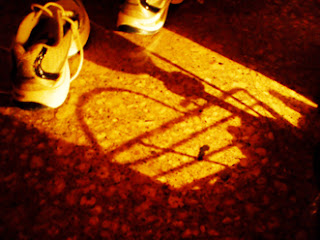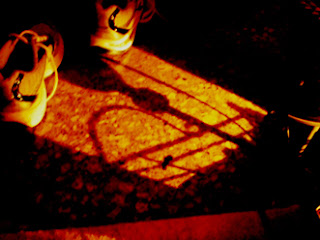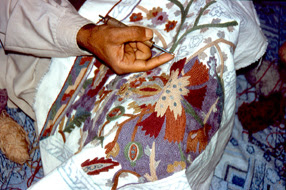 Its Sunday, I usually lie in but
woke up early today. Actually, I woke up at 2.00 am and oddly, started taking
photographs of shadows, of various things around my bedside, created by the soft
yellow light I had switched on to drink some water. Thereafter I did not go
back to sleep. I tried, but in doing yoga nidra, so that I could relax and get
back to sleep I started meditating but, did fall asleep eventually. When I woke
up, the first thing I wanted to do was to pick up the camera and examine photos
of the scene which had mesmerised me in that half asleep state.
Its Sunday, I usually lie in but
woke up early today. Actually, I woke up at 2.00 am and oddly, started taking
photographs of shadows, of various things around my bedside, created by the soft
yellow light I had switched on to drink some water. Thereafter I did not go
back to sleep. I tried, but in doing yoga nidra, so that I could relax and get
back to sleep I started meditating but, did fall asleep eventually. When I woke
up, the first thing I wanted to do was to pick up the camera and examine photos
of the scene which had mesmerised me in that half asleep state.
But, I first made a pot of tea to
accompany this exercise. I used Orange Pekoe Darjeeling tea leaves with a dash
of Nilgiri. They worked well together. The warm, afternoon flavour of a
southern Nilgiri complemented the rather smoky flavour of the north Indian Orange
pekoe. I drank my tea, listening to Dvorak’s Cello Concerto in B minor, which
is utterly soulful and the sombre cello appropriately reflective of my introspective
mood. On most occasions it moves me to tears.
The second movement of the concerto – Adagio ma non troppo[i] is
my favourite part. In this 1978 recording I listened to, it is played by the
renowned Russian Cellist Mstislav Rostropovich[ii]
with the London Philharmonic Orchestra, conducted by Carla Maria Guilini. This
flawless, incredibly moving performance by Rostropovich is considered one of
the greatest recordings of the twentieth century.
[I could not find this Rostropovich recording on the net, but this is a fabulous rendition of Dvorak's Adagio by Jaqueline du Pre]
The sublime adagio was written by
Dvorak in memory of his pupil Josefina whom he had fallen in love with but who
became his sister-in-law, not his wife. His deep affection for her remained and
it was news of her failing health that changed the tenor of this concerto,
which had started as an essay in retrospection of landscapes, to that of lost
loves. The melody moves poignantly from its initial rustic flavour to that of a
lover’s anguish. Written in New York in the winter of 1894-95, the
Czechoslovakian composer’s passionate melodic outburst includes traces of an
earlier composition – a song favoured by Josefina. This sad story always
heightens my appreciation of the heart rending music it inspired. This morning,
it complimented my soulful mood, allowing me to wallow.
It was September, we had not had much
rain this monsoon but it did rain last night, after a long dry spell. The
heavens poured and when I woke in the middle of the night, I stood awhile just observing
the clouds shed their elongated tears as the earth soaked it all in. After this
downpour the sun was out today but, the tone of the day was somehow still melancholic.
I lit a candle, in a caddy, to heat up few drops of geranium essential oil for
an uplifting fragrance. And then, picked up my point and shoot Olympus camera
and studied the photographs I had taken while half asleep in the wee hours of
the morning.
 It was the same scene I had
photographed also around 11.35 pm - of the shadow contours of a tray, a light
and wires, created by the bedside light behind them, onto the granite floor,
drawing me into the darkness, lines and textures of the imagery. The colour tones
are all shades of brown - from almost golden to raw sienna, dark umber and the
dark grey of the lamp that I use, when I embroider at night. It has a
fluorescent tube which helps balance the otherwise predominantly yellow incandescent
light in the room. It helps me work better with coloured threads if the light
is neither yellow nor fluorescent. This lamp has a long horizontal, tubular
shade to house the tube, but looks different in the shadow where it resembles
something akin to an upright vase, with a short stand and then an equally short,
but tubular receptacle rising vertically above it. It’s an odd shape.
It was the same scene I had
photographed also around 11.35 pm - of the shadow contours of a tray, a light
and wires, created by the bedside light behind them, onto the granite floor,
drawing me into the darkness, lines and textures of the imagery. The colour tones
are all shades of brown - from almost golden to raw sienna, dark umber and the
dark grey of the lamp that I use, when I embroider at night. It has a
fluorescent tube which helps balance the otherwise predominantly yellow incandescent
light in the room. It helps me work better with coloured threads if the light
is neither yellow nor fluorescent. This lamp has a long horizontal, tubular
shade to house the tube, but looks different in the shadow where it resembles
something akin to an upright vase, with a short stand and then an equally short,
but tubular receptacle rising vertically above it. It’s an odd shape. On the low, marble bed-side table
lays an aluminium framed raffia tray with wobbly metal handles on either side. It
is an old tray; gifted one Diwali long ago, filled with nuts and chocolates. I now
use it to hold the night water-thermos and sundry stuff on my bedside. There is
also a wicker waste-paper basket in the vicinity of the bedside paraphernalia
and, in the near darkness of the night-photos I am drawn into the odd shapes
and patterns of this scene which also features my Reeboks. They, however, are not creating any shadows. Although
slightly yellowed by the light, the otherwise white and blue of the shoe design
is clearly visible. It is mostly the heel and contour of the base that is seen.
Their lighter colour adds depth to the shadows and the contrast highlights
their presence in the picture. I notice they are positioned as if someone had
just taken a couple of footsteps.
On the low, marble bed-side table
lays an aluminium framed raffia tray with wobbly metal handles on either side. It
is an old tray; gifted one Diwali long ago, filled with nuts and chocolates. I now
use it to hold the night water-thermos and sundry stuff on my bedside. There is
also a wicker waste-paper basket in the vicinity of the bedside paraphernalia
and, in the near darkness of the night-photos I am drawn into the odd shapes
and patterns of this scene which also features my Reeboks. They, however, are not creating any shadows. Although
slightly yellowed by the light, the otherwise white and blue of the shoe design
is clearly visible. It is mostly the heel and contour of the base that is seen.
Their lighter colour adds depth to the shadows and the contrast highlights
their presence in the picture. I notice they are positioned as if someone had
just taken a couple of footsteps.
The warm tone of shadows around
this is comforting even though the forms and the darker hues are disconcerting.
More than anything else what perplexes me is that this scene is something which
I must see every night, so what is the sudden attraction? Why did I take
pictures at 11.35 pm and then also wake up at 2.00 am and take some more? The
question of what was I trying to tell myself, by drawing my attention to this
incongruous imagery, prompted much thought as I drank a pot full of Nilgiri and
Orange Pekoe tea.

They form a dark but
monochromatic canvas of some oddly shaped daubs, amid flatter shapes which are
not much more than blobs, or something that I imagine someone called Jackson
Pollock-Cezanne may have created, where ‘Pollockian’ paint daubs have been
flattened in a ‘Cezannesque’ manner. Even though I do not quite appreciate the
design, I have to admit that at 2.00 am they made a perfect backdrop, with
their motley dots and flattened daubs, for the sharp, dark, black shadows that
fell upon them.
This contrast is offset by the softer
raffia weave of the night-tray which is complimented by the raffia of the wicker
basket, and all together it is quite a picture. The Reeboks are placed as if I
had just taken them off. This is odd, as I have been swimming and therefore
could not have worn them for a while. Is this merely a coincidence, or something
that alludes to someone about to run away from the scene? Or maybe it could be
an indication of someone walking into it? My shoes, at home, on a night that I
cannot sleep and am taking photographs at 2.00 am, is certainly not a
coincidence.
 I have been busy. The last couple
of weeks have been hectic. Something or the other needs attention, or so I tell
myself, even as I know that mostly what really needs attention is in my mind. I
have observed how much my thoughts are responsible for whatever is going-on in
the external world, in my life as it unfolds but, still, I seem to be avoiding
something. Tricky and discomfiting, but true.
I have been busy. The last couple
of weeks have been hectic. Something or the other needs attention, or so I tell
myself, even as I know that mostly what really needs attention is in my mind. I
have observed how much my thoughts are responsible for whatever is going-on in
the external world, in my life as it unfolds but, still, I seem to be avoiding
something. Tricky and discomfiting, but true.
I understand; I am aware of how
things work but feel the resistance nonetheless. I have used my mind for all
sorts of tense situations this past week and I really do not want to do more
mental work at this point. I’d much rather focus on Dvorak’s lost love, and
listen to his heart wrenching anguish than do some deep analysis of my own
thoughts. Neither am I silent enough to ‘feel’ things beyond the emotional. In
such a scenario, pushing myself only succeeds in getting me to switch on the
internet and play scrabble on Facebook instead. Or play detective and study the
‘crime scene’, examining unattractive floor tiles in my apartment, as I have
done for the better part of this morning.
However, this exercise has not
been such a waste of time. Through a preliminary study of the photographs and reflections,
I realise it is not the shadows that have much to say. They set the tone by highlighting
the shoes which suggested someone could be entering, leaving or something along
those lines. I know I should do some serious contemplation. A little coaxing always
helps and its amazing how in that half-asleep state, I took photos which
intrigued, leading to ruminations on the granite canvas, to realise that
everything was not quite under control as I had thought when I turned in, to
sleep last night.
Fascinating as the subtle nuances
of life can be, sometimes I just do not want to go deeper and I do get my moments
of reprieve. But, then, just like with these ‘2.00 am shadows’, some unseen
energy finds a way to nudge me to into paying more attention to my thoughts and
not sleep-walk through life.













